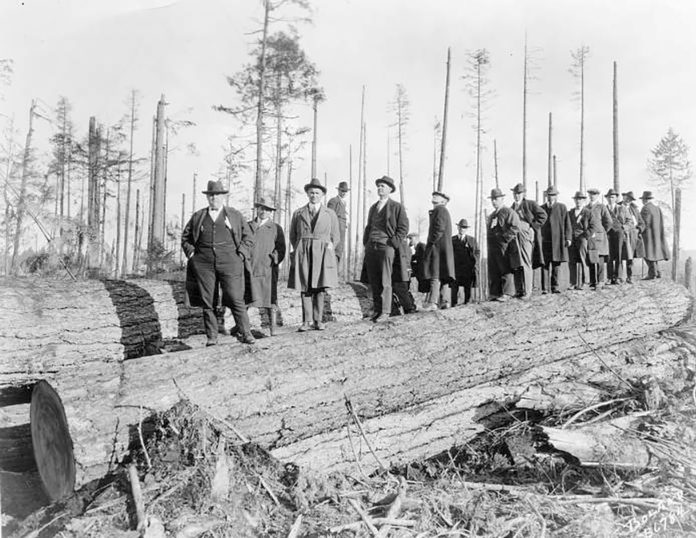In 1922 when delegates to the 13th annual Pacific Logging Congress assembled in Tacoma, production from Washington’s forests yielded 5.6 billion board feet of timber, more than double the state’s 2022 output. It was also more than triple that of 1900. The 1920s produced the second biggest harvest, 65 billion board feet for any Washington state decade, eclipsed only by the 1970s’ output of 68 billion.
Washington’s lumber industry originated during efforts to supply growth caused by the California Gold Rush boom of 1848. Most of that demand was supplied from sawmills built on the shores of Puget Sound or on rivers large enough for ships to enter. As more settlers poured into the Pacific Northwest, thanks to the establishment of railroads in the 1880s, local demand from growing cities and burgeoning coal mines fueled sawmills built inland away from the coast and rivers.
Yet how timber was supplied to the sawmills was little changed from logging practices over the previous centuries – with teams of horses or mules, but mostly oxen pulling bark-removed logs along oiled logs placed perpendicular to create what was called a corduroy or skid road. Soon enough, small gauge rail roads replaced skid roads and the introduction of steam engines revolutionized how trees were brought to a central landing.
The next profound change, around 1910, was the debut of overhead yarding systems powered by steam donkeys. This technology, such as the Lidgerwood Cableway Skidder utilized a tall spar pole or standing tree stripped of all branches and hung with pulleys strung with steel cables called high leads. Overhead cable yarding (i.e. pulling logs to the landing) suspended the leading edge of logs in the air rather than being dragged along the ground where friction, stumps, and topography created multiple obstacles. The power of leverage allowed logs to more easily be brought to a central landing for shipping to mills. Several of the presentations given to the 500 delegates at the convention focused on the relative merits of fixed boom yarding versus swing boom; and tight line yarding system compared to slack lines.
A special excursion train transported many of the conventioneers from Tacoma’s Union Station on a field trip to the St. Paul & Tacoma Lumber Company’s camp at Kapowsin, located about 16 miles southeast of Puyallup. This photo dated Oct. 28, 1922, shows 16 of those delegates assembled atop a pile of old growth logs. At the time Tacoma fancied itself “the lumber capital of America,” due to the number of local sawmills and amount of wood products shipped from the city’s ports on Commencement Bay.
During its heyday, the St. Paul & Tacoma Lumber Co. was the second largest lumber and logging operation in Washington, controlling 90 square miles of timber in Pierce County. In 1958, St. Paul & Tacoma merged with St. Regis Paper Company. The land was transferred through merger or acquisition to Champion International and International Paper, then sold to Rayonier Timber, then Rainier Timber, managed by the Campbell Group, and finally Hancock Forest Management, now renamed Manulife. The Kapowsin tree farm forest is still a major timber producing region 100 years later.
Photo number Boland-B6784 comes courtesy of the Northwest Room in the Tacoma Public Library which also provided news articles from the late October 1922 issues of the Tacoma News Tribune and Tacoma Daily Ledger. Next week, this column visits the White River Lumber Company sawmill in Enumclaw, where the Grandma of the Gangsaw worked.







